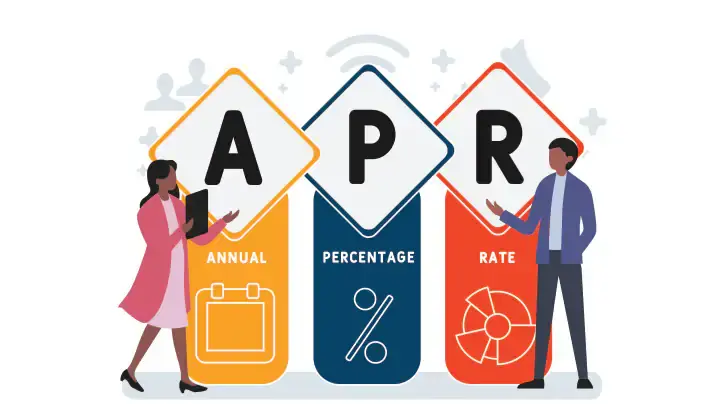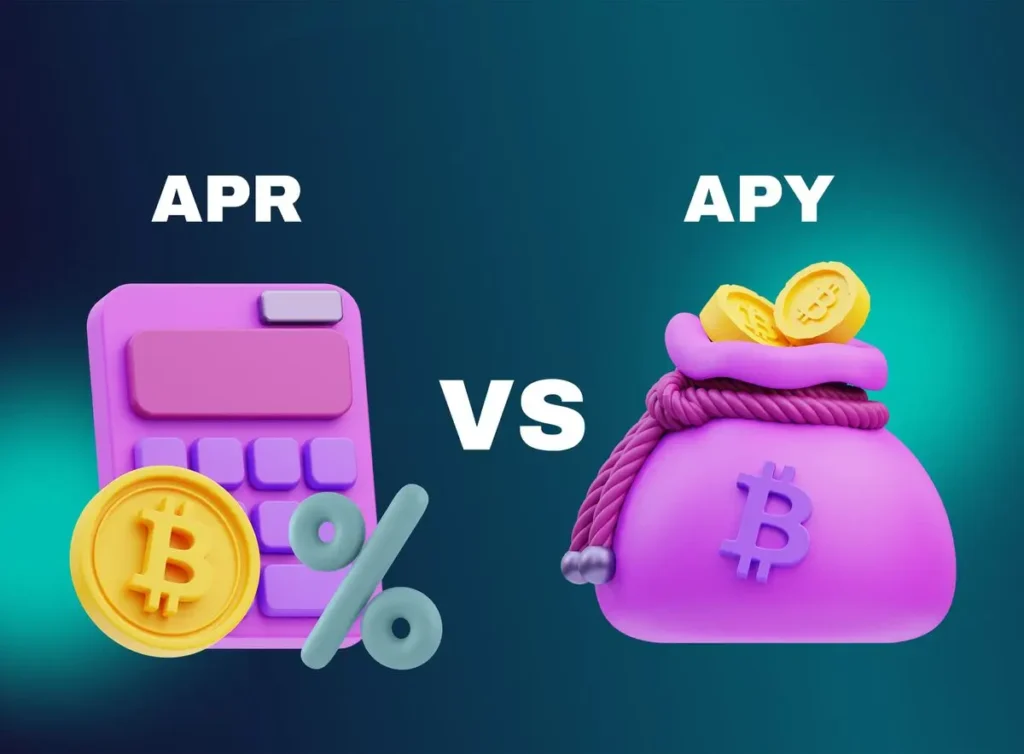Wondering how much interest your crypto investments might earn over time? A crypto APR calculator can help you find out. These useful tools estimate potential earnings based on your initial investment, interest rate, and time period.
A crypto APR (Annual Percentage Rate) calculator shows you the simple interest you could earn on your cryptocurrency investments without considering compounding effects. Unlike APY calculators which include compound interest, APR calculators provide a straightforward view of your potential returns.
Using a crypto APR calculator is straightforward and helps with planning your investment strategy. You can compare different investment options, platforms, and timeframes to make better decisions about where to put your crypto. Many platforms like Binance and CoinCodex offer free calculators to help you estimate your potential earnings.
Understanding Crypto APR

Annual Percentage Rate (APR) is a key metric for evaluating potential returns in cryptocurrency investments. It helps you compare different investment opportunities and understand what you might earn over time.
Definition and Importance
APR stands for Annual Percentage Rate, representing the yearly interest earned on your cryptocurrency investments without accounting for compounding effects. In the crypto world, APR is commonly used to express potential earnings from staking, lending, or depositing your digital assets on various platforms.
To calculate crypto APR, you divide the total interest earned over a year by your initial investment amount. For example, if you invest 1,000 USDC and earn 50 USDC in interest over a year, your APR would be 5%.
APR is important because it provides a standardized way to compare different crypto investment options. Higher APR generally means better returns, but it’s crucial to consider other factors like platform security, lock-up periods, and potential risks.
APR vs. APY: What’s the Difference?

APR and APY (Annual Percentage Yield) are often confused, but they represent different measurements of returns in crypto investing.
The main difference is that APR shows simple interest without compounding, while APY accounts for compound interest. Compounding occurs when your earnings generate additional earnings over time.
For example, with a 10% APR paid monthly:
- APR: 10% annually (simple interest)
- APY: 10.47% annually (including compounding effects)
APY will always be higher than APR when interest compounds more than once per year. Many crypto platforms advertise APY to showcase higher potential returns, making investments seem more attractive.
When evaluating crypto opportunities, you should understand which metric is being used. For accurate comparisons between platforms, convert all rates to the same measurement (either APR or APY).
Key Components of APR Calculation
Understanding APR in crypto requires knowing three main factors that affect your returns. These components work together to determine how much you’ll earn from staking or lending your cryptocurrency.
Interest Rate
The interest rate forms the foundation of any APR calculation. In crypto, this represents the basic percentage you earn for staking or lending your assets. Unlike traditional finance, crypto interest rates can vary widely between platforms and tokens.
To calculate a basic crypto APR, divide the total interest earned in a year by your initial investment amount. For example, if you stake 1 ETH and earn 0.05 ETH in a year, your simple interest rate is 5%.
Many DeFi platforms display their interest rates prominently, but these rates may fluctuate based on market conditions. It’s important to check if the rate is fixed or variable before committing your funds.
Loan Term
The loan term refers to how long you plan to stake or lend your crypto assets. This period directly impacts your total returns.
Most crypto platforms calculate APR based on an annual (365-day) timeframe. However, your actual staking period might be shorter or longer. Some protocols allow flexible terms where you can withdraw anytime, while others require lockup periods.
To determine your earnings for non-annual periods, you must adjust the APR calculation. For example, if a platform offers 12% APR and you stake for 3 months, you would earn approximately 3% (12% ÷ 4) during that period.
Be aware that early withdrawals might incur penalties or result in forfeited rewards on certain platforms.
Compound Frequency
Compound frequency determines how often your earned interest is added to your principal, generating additional returns. Unlike simple interest (APR), compounding can significantly increase your actual yields.
In crypto, compounding can happen at various intervals: daily, weekly, monthly, or even per block. More frequent compounding generally results in higher total returns.
For example, $1,000 invested at 10% APR with annual compounding would yield $1,100 after one year. The same investment with daily compounding would yield about $1,105.
This is why many platforms advertise APY (Annual Percentage Yield) alongside APR. APY includes the effect of compounding, giving you a more accurate picture of your potential returns. When comparing different crypto staking options, always check the compounding frequency to understand your true earning potential.
Calculating APR for Crypto Investments
Understanding how to calculate Annual Percentage Rate (APR) for your crypto investments helps you make better financial decisions. Knowing the exact return on your investments allows you to compare different opportunities and maximize your earnings.
Step-by-Step Calculation Process
To calculate crypto APR manually, follow these steps:
- Identify the interest rate provided by the platform or protocol
- Determine the investment period (usually expressed in days)
- Calculate the daily interest rate by dividing the annual rate by 365
- Multiply the daily rate by your investment amount to find daily earnings
- Extend calculation to the full investment period
For example, if a platform offers 10% APR and you invest 1 BTC, your daily earnings would be: 1 BTC × (10% ÷ 365) = 0.000274 BTC per day.
Remember that APR doesn’t account for compounding effects, which is why APY (Annual Percentage Yield) might be more relevant for reinvested earnings.
Tools and Formulae
Several online calculators can help you determine potential crypto earnings:
- CoinCodex Calculator: Easy-to-use tool for calculating potential interest
- Binance Calculator: Estimates rewards in cryptocurrency over selected timeframes
- EarnPark Calculator: Factors in interest rate and compounding period
The basic APR formula is:
APR = (Interest Earned / Principal Amount) × (365 / Days) × 100%
For investments with regular compounding, the formula becomes more complex:
FV = P(1 + r/n)^(nt)
Where FV is future value, P is principal, r is rate, n is compounds per year, and t is time in years.
Examples of Crypto APR Calculations
Example 1: Staking ETH
You stake 10 ETH at 5% APR for one year.
Earnings calculation: 10 ETH × 5% = 0.5 ETH after one year
Monthly earnings: 0.5 ETH ÷ 12 = 0.0417 ETH per month
Example 2: Lending USDC
You lend 1,000 USDC at 8% APR on a lending platform.
Annual earnings: 1,000 USDC × 8% = 80 USDC
Daily earnings: 80 USDC ÷ 365 = 0.219 USDC per day
Example 3: Liquidity Pool
You provide $5,000 worth of assets to a liquidity pool offering 12% APR.
Monthly earnings: $5,000 × 12% ÷ 12 = $50 per month
Remember that crypto APRs often fluctuate based on market conditions. Always check current rates before making investment decisions.
How APR Affects Crypto Earnings
Annual Percentage Rate (APR) directly influences how much money you can make from your crypto investments. Understanding APR helps you predict your potential returns and make better investment choices.
Earnings Estimation
APR helps you calculate how much interest your crypto will earn over time. If you invest $1,000 in a crypto platform offering 5% APR, you can expect to earn about $50 in a year.
Most crypto platforms display APR as a simple percentage. To calculate your earnings:
- Daily earnings = (Investment × APR) ÷ 365
- Monthly earnings = (Investment × APR) ÷ 12
- Yearly earnings = Investment × APR
Unlike APY, APR doesn’t account for compound interest. This means if you’re reinvesting your earnings, your actual returns may be higher than what APR suggests.
Many platforms now offer crypto APR calculators that do the math for you. These tools let you input different APR rates, investment amounts, and timeframes to see potential earnings.
Impact on Investment Decisions
APR rates vary widely across different cryptocurrencies and platforms. Some stablecoins might offer 8-12% APR, while Bitcoin might only offer 3-5% on lending platforms.
Higher APR often comes with higher risk. Before choosing an investment based solely on high APR, consider:
- Platform security – Is the exchange or DeFi protocol trustworthy?
- Market volatility – High APR won’t help if the token loses significant value
- Lock-up periods – Some higher APR options require you to lock your crypto for months
Comparing APR between different crypto options helps you maximize your passive income. Many investors diversify across several APR-generating investments to balance risk and reward.
Remember that APR rates in crypto aren’t guaranteed and can change based on market conditions.
Factors Influencing Crypto APR
Cryptocurrency Annual Percentage Rates (APR) fluctuate based on several key influences. These factors directly impact how much you earn through staking, lending, or other yield-generating activities in the crypto space.
Market Volatility
Market volatility significantly affects crypto APR rates. During highly volatile periods, APRs can change dramatically as platforms adjust their rates to manage risk.
When markets experience extreme price swings, lending platforms often increase APRs to attract more deposits and maintain liquidity. This happens because volatile conditions create uncertainty, and higher rewards are needed to compensate for increased risk.
Conversely, stable market periods typically result in lower APRs. You’ll notice this pattern across most crypto platforms – when Bitcoin or other major cryptocurrencies experience price stability, yield offerings tend to decrease.
Bot settings and automated trading tools also impact APRs during volatile markets. Many yield platforms use algorithms that automatically adjust rates based on market conditions, leading to dynamic APR changes that directly affect your potential earnings.
Regulatory Environment
Regulatory decisions have powerful effects on crypto APRs across different jurisdictions. When governments implement crypto-friendly policies, platforms often operate with lower compliance costs and can offer more competitive rates.
Conversely, strict regulations or uncertainty can force platforms to reduce APRs. This happens because they must allocate more resources to compliance and risk management, eating into the returns they can offer you.
Tax policies specifically impact net APR returns. Depending on your location, interest earned may be subject to different tax treatments, effectively reducing your real yield.
You should monitor regulatory announcements in your region, as sudden changes can quickly impact available rates. Some platforms even restrict services in certain jurisdictions due to regulatory pressure, limiting your access to higher APR opportunities.
Project’s Economic Model
The underlying tokenomics and economic design of a crypto project fundamentally determine its sustainable APR. Projects with solid revenue models can maintain consistent APRs without relying solely on token inflation.
Inflation-based rewards are common in many proof-of-stake networks. When new tokens are created primarily to pay stakers, the APR may look attractive initially but can diminish in real value over time.
You’ll find more sustainable APRs in projects that generate actual revenue through fees, services, or other business activities. These projects can offer yields backed by real economic activity rather than just token creation.
The development stage of a project also matters. New projects often offer higher APRs to attract early participants, but these rates typically decrease as the network matures and becomes more stable.
Frequently Asked Questions
Crypto APR calculations can be complex, but understanding a few key concepts will help you maximize your investment returns. Let’s address some common questions about calculating potential earnings, available tools, and important distinctions in crypto interest rates.
How can you use a crypto APR calculator to determine potential staking returns?
A crypto APR calculator helps you estimate earnings from staking your digital assets. Simply input your initial investment amount, the APR rate offered by the platform, and your planned investment duration.
Most calculators will show you projected earnings over different time periods – daily, weekly, monthly, and yearly. This gives you a clear picture of potential returns before committing your crypto to a staking program.
Remember that APR calculations assume the interest rate remains constant, which isn’t always the case in volatile crypto markets.
What tools are available for calculating daily APR on cryptocurrency investments?
Many cryptocurrency exchanges like Binance offer built-in APR calculators on their platforms. These tools allow you to see potential earnings before staking or lending your assets.
Independent websites like APY.Vision, DeFi Rate, and StakingRewards provide comparison tools across multiple platforms. These sites help you find the best rates available for your specific cryptocurrencies.
Mobile apps dedicated to crypto investment tracking often include APR calculation features to help you monitor potential earnings on the go.
How do you calculate compound interest on crypto assets?
The compound interest formula for crypto is: Final Amount = Principal × (1 + r/n)^(n×t), where r is the annual interest rate as a decimal, n is the number of compounding periods per year, and t is time in years.
For daily compounding, which is common in crypto, n equals 365. Many staking platforms automatically reinvest your earnings, creating a compounding effect that accelerates your returns over time.
Using a dedicated calculator is often easier than manual calculations, especially for varying rates or complex compounding schedules.
What are the differences between APR and APY in the context of cryptocurrency?
APR (Annual Percentage Rate) shows the simple interest earned over a year without accounting for compounding. It’s a straightforward measure of basic returns.
APY (Annual Percentage Yield) includes the effect of compounding, showing the total return when earnings are reinvested. APY is always higher than APR for the same stated rate.
Crypto platforms may advertise either measure, so understanding the difference helps you make accurate comparisons. APY gives you a more realistic picture of potential earnings when compounding is involved.
Can you explain the calculations involved in converting APR to APY for crypto investments?
To convert APR to APY, use this formula: APY = (1 + APR/n)^n – 1, where n is the number of compounding periods per year.
For daily compounding, which is common in crypto staking, you would use n=365. For example, a 5% APR with daily compounding becomes an APY of 5.13%.
The more frequent the compounding, the greater the difference between APR and APY. This difference becomes more significant with higher interest rates.
What factors should you consider when comparing APR rates offered by different crypto platforms?
Look beyond the headline APR rate to understand lock-up periods and withdrawal restrictions. Some platforms require you to lock your assets for months to receive the advertised rates.
Consider platform security and reliability. Higher APR rates often come with increased risk, so evaluate the platform’s security history and insurance coverage.
Check for variable versus fixed rates. Some platforms offer high introductory rates that decrease over time or as more users join the platform.
Pay attention to minimum deposit requirements and any fees that might reduce your actual returns. These can significantly impact your net earnings despite attractive APR numbers.
